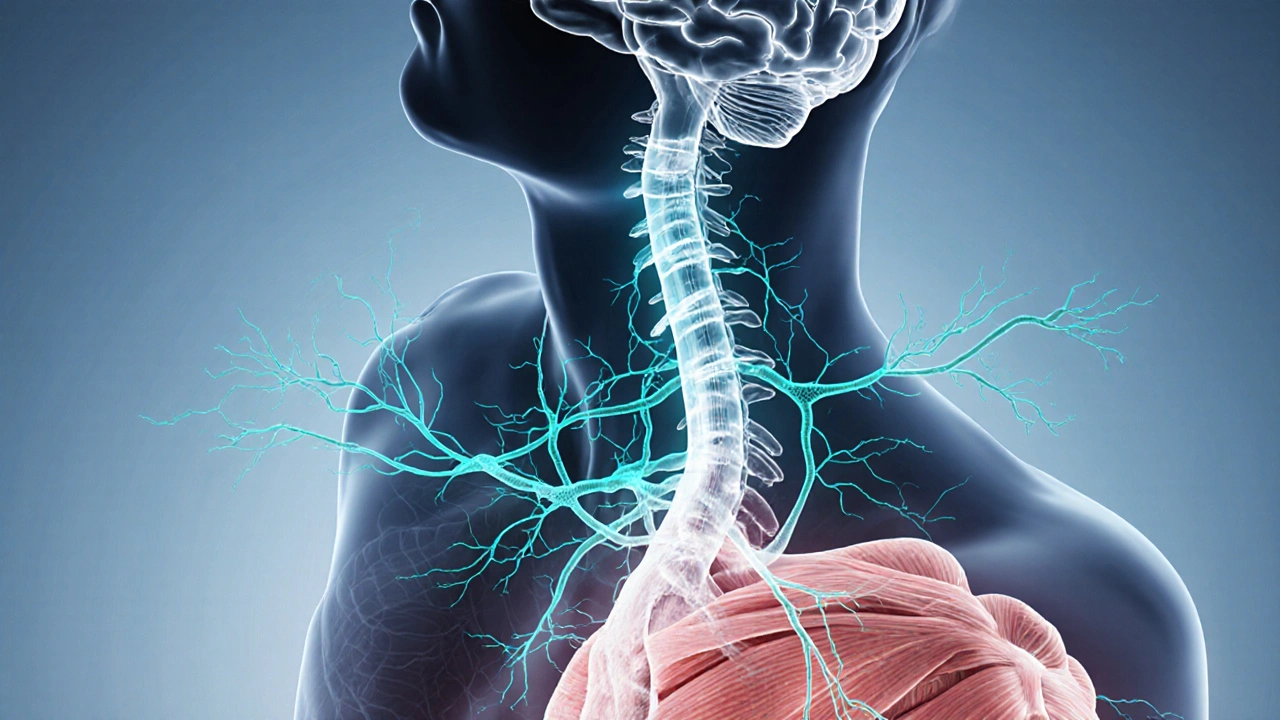Poor Muscle Control Symptom Checker
This tool helps identify possible causes of poor muscle control based on reported symptoms. It is not a substitute for professional medical advice.
Click on each symptom to select or deselect it. Results will update automatically.
Select Your Symptoms:
Possible Causes:
Select symptoms to see possible causes.
Poor muscle control is often caused by disruptions in the neuromuscular system, including:
- Central nervous system conditions like stroke or Parkinson’s disease
- Spinal cord injuries or peripheral nerve damage
- Muscle disorders such as muscular dystrophy
Ever felt like your muscles just won’t obey you? That loss of precise movement - known as poor muscle control - can be frustrating, scary, and sometimes a sign that something deeper is off. This guide walks through what drives that loss of control, the red‑flag symptoms to watch, and the steps you can take to get back on track.
Key Takeaways
- Poor muscle control stems from disruptions in the neuromuscular system, ranging from strokes to peripheral nerve damage.
- Common symptoms include tremor, spasms, clumsiness, and difficulty with fine motor tasks.
- Accurate diagnosis often combines physical exams, EMG testing, and imaging like MRI.
- Treatment blends therapy, medication, and lifestyle tweaks - early intervention improves outcomes.
- Seek professional help if symptoms worsen, affect daily living, or appear suddenly.
What Is Poor Muscle Control?
Poor Muscle Control is a condition where the brain, spinal cord, or peripheral nerves fail to coordinate muscle activity properly. This results in weak, shaky, or uncoordinated movements that can affect anything from gripping a pen to walking up stairs. The problem isn’t the muscle fibers themselves - they’re typically healthy - but the signals that tell them when and how to contract.
How the Neuromuscular System Keeps Muscles in Sync
Think of your body as a well‑orchestrated orchestra. The Neuromuscular System includes the brain, spinal cord, motor neurons, and the peripheral nerves that transmit commands to muscles. When any part of this chain falters, the music turns into a cacophony.
Key players:
- Motor Neuron carries electrical impulses from the spinal cord to muscle fibers
- Cerebellum fine‑tunes movement, balance, and coordination
- Basal Ganglia initiates and regulates voluntary motions
When any of these structures are damaged, the result can be poor muscle control.
Common Causes
Below is a quick snapshot of the most frequent culprits, grouped by where the disruption occurs.
| Category | Typical Conditions | How It Affects Control |
|---|---|---|
| Central Nervous System | Stroke sudden loss of blood flow to brain tissue, Parkinson’s Disease degenerative loss of dopamine‑producing cells, Multiple Sclerosis immune‑mediated demyelination of CNS pathways | Disrupts signal routing, causing tremor, rigidity, or delayed responses. |
| Spinal Cord & Nerves | Spinal Cord Injury trauma that severs or compresses spinal pathways, peripheral neuropathy, radiculopathy | Interrupts motor neuron output, leading to weakness or spasticity below the injury level. |
| Muscle & Connective Tissue | Muscular dystrophy, myopathy | Altered muscle fiber composition reduces strength, but control issues often stem from nerve‑muscle mismatch. |
Let’s unpack the top three neurology‑related causes because they account for the majority of adult cases.
Stroke
A Stroke occurs when blood supply to part of the brain is blocked or ruptured. The damaged brain region can’t send correct commands to muscles, resulting in one‑sided weakness (hemiparesis), spasticity, or loss of fine motor skills. Early rehab focuses on re‑training neural pathways through repetitive movement and task‑specific exercises.
Parkinson’s Disease
In Parkinson’s Disease the substantia nigra loses dopamine‑producing neurons, leading to motor slowness and tremor. The basal ganglia can’t properly modulate the motor cortex, so patients experience resting tremor, rigidity, and gait instability - classic forms of poor muscle control.
Multiple Sclerosis (MS)
Multiple Sclerosis is an autoimmune disease that attacks the myelin sheath of CNS neurons. Demyelination slows electrical conduction, causing delayed or inaccurate muscle activation. Symptoms can be intermittent, making diagnosis tricky.

Recognizing the Symptoms
Spotting poor muscle control early improves outcomes. Common signs include:
- Tremor at rest or during movement.
- Spasticity - muscles feel tight, move in jerky bursts.
- Ataxia - unsteady gait, difficulty balancing.
- Difficulty with fine motor tasks (buttoning, writing).
- Unexplained fatigue or muscle “clumsiness” that worsens throughout the day.
If you notice a sudden onset (e.g., after a fall) or a progressive pattern over weeks, it’s time to seek evaluation.
How Doctors Diagnose Poor Muscle Control
Diagnosis is a step‑by‑step process that pieces together the puzzle.
- Clinical Examination: Neurologists assess strength, reflexes, tone, and coordination using standardized tests such as the NIH Stroke Scale or the Unified Parkinson’s Disease Rating Scale.
- Electromyography (EMG): This test records electrical activity in muscles while at rest and during contraction, helping differentiate nerve‑origin problems from primary muscle disorders.
- Imaging: MRI or CT scans visualize brain and spinal cord lesions, confirming strokes, demyelination, or structural injuries.
- Blood Tests: Identify metabolic causes (e.g., vitamin B12 deficiency) that can mimic neuromuscular dysfunction.
These tools together pinpoint the exact location of the signal breakdown, guiding treatment.
Managing Poor Muscle Control
There’s no one‑size‑fits‑all cure, but a multi‑disciplinary approach works best.
Physical & Occupational Therapy
Therapists employ repetitive, task‑specific drills to re‑wire neural pathways - a concept called neuroplasticity. Examples include:
- Constraint‑induced movement therapy for stroke survivors.
- Balance boards and gait training for ataxia.
- Fine‑motor exercises using putty or beads for tremor management.
Medications
When the cause is neurological, drugs can reduce abnormal signals:
- Baclofen or tizanidine for spasticity.
- Levodopa for Parkinsonian tremor.
- Corticosteroids during acute MS relapses.
Medication choice depends on the underlying diagnosis and side‑effect profile.
Lifestyle Tweaks
- Maintain adequate hydration and electrolytes - low potassium can worsen muscle weakness.
- Regular aerobic activity improves overall circulation and supports neuroplastic changes.
- Stress‑reduction techniques (yoga, meditation) can lower muscle tension that masks control issues.
When to Seek Professional Help
Don’t wait for symptoms to become severe. Look for any of these red flags:
- Sudden loss of movement on one side of the body.
- New onset tremor that interferes with daily tasks.
- Progressive worsening despite rest or home exercises.
- Painful spasms or uncontrolled shaking that leads to falls.
Early referral to a neurologist or physiatrist can fast‑track proper testing and start rehab before permanent deficits set in.
Frequently Asked Questions
Can poor muscle control be reversed?
Reversal depends on the cause. Stroke‑related deficits often improve dramatically with intensive therapy, while degenerative diseases like Parkinson’s may only be managed. Early intervention always yields better outcomes.
Is EMG painful?
A fine needle inserts briefly into the muscle, causing a brief pinch. Most patients tolerate it well, and the information it provides is crucial for accurate diagnosis.
What lifestyle changes help improve muscle control?
Regular low‑impact cardio, strength training, adequate sleep, and stress reduction techniques can all boost neural health and muscle responsiveness.
Are there any home exercises for tremor?
Yes. Simple tasks like tracing circles with a pen, using therapy putty, or holding a cup of water while gently shaking can strengthen the fine‑motor pathways. Consistency (5‑10 minutes daily) matters more than intensity.
When should I see a neurologist versus a physical therapist first?
If symptoms appear suddenly, are accompanied by weakness on one side, or include speech changes, see a neurologist immediately. For gradual clumsiness or mild tremor, starting with a physical therapist can be a practical first step.


Early recognition of poor muscle control can dramatically change the trajectory of recovery, because the nervous system retains a remarkable capacity for plasticity when it is challenged appropriately. Physical therapists often employ repetitive, task‑specific exercises that reinforce the damaged pathways, allowing surviving neurons to take over lost functions. In stroke patients, constraint‑induced movement therapy forces the use of the affected limb, which drives cortical re‑mapping and improves strength. Pharmacologic agents such as baclofen for spasticity or levodopa for Parkinsonian tremor can be adjuncts, but they rarely correct the underlying signal disruption on their own. Nutrition also plays a subtle role; adequate vitamin B12 and electrolytes support neurotransmitter synthesis and muscle excitability. Regular aerobic activity improves cerebral perfusion, which may help mitigate the progression of demyelinating conditions like multiple sclerosis. Psychological support should not be overlooked, because anxiety can exacerbate tremor and muscle tension, creating a feedback loop that hinders rehabilitation. Occupational therapists contribute by teaching adaptive strategies for daily tasks, ensuring that patients maintain independence while they regain control. Imaging studies, especially MRI, can pinpoint lesions that inform targeted therapy, whether surgical or rehabilitative. Electromyography helps distinguish neuropathic from myopathic origins, guiding clinicians toward the correct treatment pathway. For peripheral nerve injuries, nerve gliding exercises and electrical stimulation have shown modest benefits in restoring conduction. Education on proper body mechanics reduces the risk of secondary injuries that could compound the existing control deficits. Family involvement is crucial; caregivers who understand the importance of consistent practice can reinforce therapeutic gains at home. Ultimately, a multidisciplinary approach that blends physical, pharmacologic, and psychosocial interventions offers the best chance for meaningful improvement. Consistency, patience, and early engagement remain the cornerstones of effective management.
Great rundown! 😃 The part about neuroplasticity really hits home, especially since many people think the brain is set in stone after an injury. Keeping the momentum with daily drills makes all the difference, and a little humor never hurts when the workouts get tough. 🎉
It's reassuring to see the emphasis on both medical and lifestyle interventions. A balanced diet, adequate hydration, and consistent sleep patterns often get sidelined, yet they are essential for nerve health. The clear distinction between EMG and imaging helps demystify the diagnostic process for newcomers. Also, the suggestion of fine‑motor exercises like therapy putty is a practical tip that can be implemented without a clinic visit.
Sure, because everyone loves sitting through a 30‑minute lecture on the basal ganglia before they can even pick up a pen. If you’ve got a tremor, just grab a coffee and pretend it’s a new dance move – that’s the kind of "friendly" advice we all needed.
Consistency beats intensity.
Exactly! Show up every day, even if it’s just a few minutes, and watch the magic unfold – think of it as a tiny rebellion against the body’s betrayal.
I love how the guide frames the neuromuscular system as an orchestra; it really paints a vivid picture of coordination. The step‑by‑step diagnostic outline is especially helpful for those who feel overwhelmed by medical jargon. Remember, even a modest walk in the park can boost circulation and support neural health, so don’t underestimate the power of simple movement.
Orchestrated nonsense! Who trusts a guide that pretends a doctor’s office isn’t a front for the elite to hide the real cause-big pharma’s hidden agenda to keep us dependent!
While it’s easy to get caught up in conspiracies, the practical steps listed here-like balanced nutrition and regular exercise-are grounded in solid science. Embracing a positive mindset can also enhance neuroplastic changes, turning challenges into opportunities for growth.
Sure, “solid science” is what they want you to believe while they keep the cure locked away. Stay vigilant, question everything, and never let the system dictate your health.